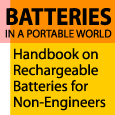 |
Table of Contents Battery FAQ New Articles About the Author Order Book Links Next page >> |
The battery has become our steady travel companion - it helps
call a friend; it expands our workplace beyond four walls; and it
supports critical missions for people in need. Performance specifications for batteries and chargers are often based on ideal conditions. Manufacturers carry out battery tests on brand new equipment within protected environments. In Batteries in a Portable World, Mr. Buchmann observes the battery as used by consumers in everyday life. The battery handbook addresses the strengths and limitations of the modern battery. It illustrates which battery chemistry is most appropriate for each application. You will learn about charger technology, battery maintenance to prolong battery life and methods to restore weak batteries with a battery analyzer. |
Table of Contents
Part One - Battery Basics Everyone Should Know
Author's NotePart Two – You and the Battery
Introduction
Chapter 1: When was the battery invented?
Chapter 2: Battery Chemistries
2.1 Chemistry Comparison
2.2 The Nickel Cadmium (NiCd) Battery
2.3 The Nickel-Metal Hydride (NiMH) Battery
2.4 The Lead Acid Battery
2.5 The Lithium Ion Battery
2.6 The Lithium Polymer Battery
2.7 Reusable Alkaline Batteries
2.8 The Supercapacitor
Chapter 3: The Battery Pack
3.1 The Cylindrical Cell
3.2 The Button Cell
3.3 The prismatic Cell
3.4 The Pouch Cell
3.5 Series and Parallel Configurations
3.6 Protection Circuits
Chapter 4: Proper Charge Methods
4.1 All About Chargers
4.2 Charging the Nickel Cadmium Battery
4.3 Charging the Nickel-Metal Hydride Battery
4.4 Charging the Lead Acid Battery
4.5 Charging the Lithium Ion Battery
4.6 Charging the Lithium Polymer Battery
4.7 Charging at High and Low Temperatures
4.8 Ultra-fast Chargers
4.9 Charge IC Chips
Chapter 5: Discharge Methods
5.1 C-rate
5.2 Depth of Discharge
5.3 Pulse Discharge
5.4 Discharging at High and Low Temperature
Chapter 6: The Secrets of Battery RuntimePart Three – Knowing Your Battery
6.1 Declining Capacity
6.2 Increasing Internal Resistance
6.3 Elevated Self-Discharge
6.4 Premature Voltage Cut-off
Chapter 7: The ‘Smart’ Battery
7.1 The Single Wire Bus
7.2 The SMBus
7.3 The State-of-Charge Indicator
7.4 The Tri-State Fuel Gauge
7.5 The Target Capacity Selector
7.6 Fuel Gauges for Large Batteries
Chapter 8: Choosing the Right Battery
8.1 What’s the best battery for mobile phones?
8.2 What’s the best battery for two-way radios?
8.3 What’s the best battery forlaptops?
8.4 Selecting a Lasting Battery
Chapter 9: Internal Battery Resistance
9.1 Why do seemingly good batteries fail on digital equipment?
9.2 How is the internal battery resistance measured?
9.3 What’s the difference between internal resistance and impedance?
Chapter 10: Getting the Most from your Batteries
10.1 Memory: myth or fact?
10.2 How to Restore and Prolong Nickel-based Batteries
10.3 The Effect of Zapping
10.4 How to Restore and Prolong Sealed Lead Acid Batteries
10.5 How to Prolong Lithium-based Batteries
10.6 Battery Recovery Rate
Chapter 11: Maintaining Fleet Batteries
11.1 The ‘Green Light’ Lies
11.2 Battery Maintenance, a Function of Quality Control
11.3 Battery Maintenance Made Simple
11.4 Battery Maintenance as a Business
Chapter 12: Battery Maintenance Equipment
12.1 Conditioning Chargers
12.2 Battery Analyzers
12.3 Battery Analyzers for Maintenance-Free Batteries
12.4 Battery throughput
12.5 Battery Maintenance Software
Chapter 13: Making Battery Quick-Test Feasible
13.1 Battery Specific Quick Testing
13.2 Three-Point Quick Test
13.3 The Evolving Battery
13.4 The Cadex Quicktest Method
13.5 How does the Cadex Quicktest work?
13.6 Battery Testing and the Internet
13.7 Electrochemical Impedance Spectroscopy
Chapter 14: Non-Correctable Battery ProblemsPart Four – Beyond Batteries
14.1 High Self-discharge
14.2 Low Capacity Cells
14.3 Cell Mismatch
14.4 Shorted Cells
14.5 Loss of Electrolyte
Chapter 15: Caring for Your Batteries from Birth to Retirement
15.1 Storage
15.2 Priming
15.3 The Million Dollar Battery Problem
15.4 To the Service Counter, and No Further
15.5 The Quick Fix
15.6 Battery Warranty
15.7 Battery Recycling
Chapter 16: Practical Battery Tips
16.1 Personal Field Observations
16.2 The Correct Battery for the Job
16.3 Battery Analyzers for Critical Missions
Chapter 17: Did you know . . . ?
17.1 The Cost of Mobile Power
17.2 The Fuel Cell
17.3 The Electric Vehicle
17.4 Strengthening the Weakest Link
Chapter 18: Beginnings and Horizons
18.1 About the Author
18.2 About Cadex
18.3 Working with Natural Beauty
18.4 Customer Comments
18.5 Cadex Products